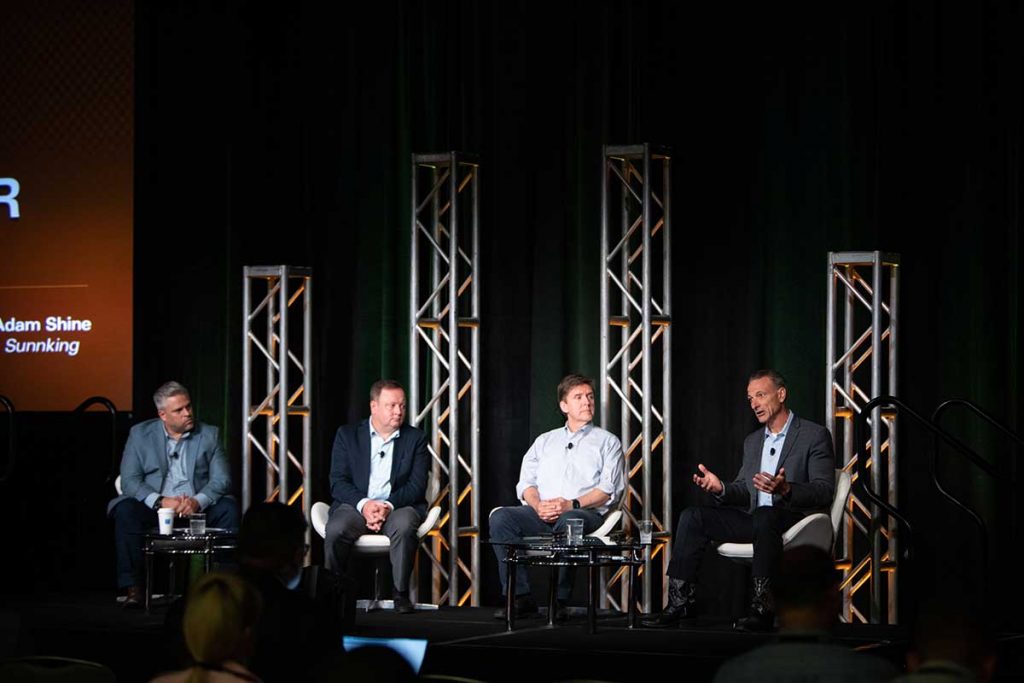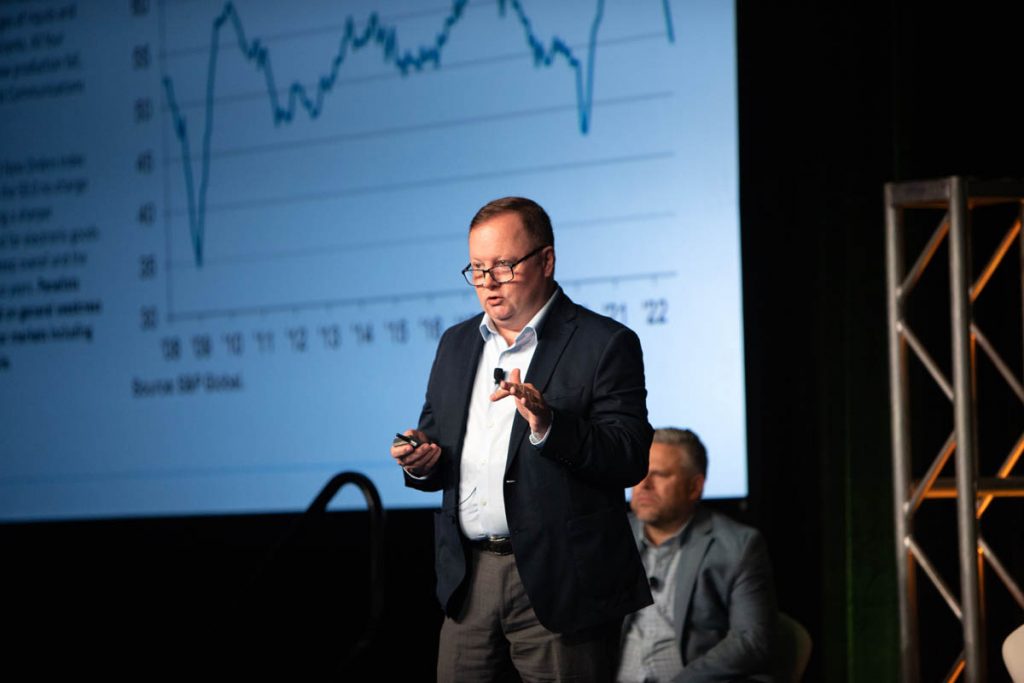
A panel moderated by Adam Shine (far left) featured market insights from Joe Pickard (second from left), Walter Alcorn (second from right) and Craig Boswell (far right). | Big Wave Productions/Resource Recycling, Inc.
Battery-embedded products, market uncertainty and evolving ITAD services are shaping the future of electronics recycling, industry experts noted last week.
During the Sept. 20 “State of Sector” session at the E-Scrap Conference, held in New Orleans Sept. 19-21, several leaders in the electronics and e-scrap industries shared their view of not only where the sector is, but where it’s headed.
Walter Alcorn, vice president of Environmental Affairs and Industry Sustainability at the Consumer Technology Association (CTA), said he’s seeing an ever-increasing number of products with embedded batteries. Smart and solar-powered devices are driving much of that growth, he noted.
“We have some really cool stuff, but I realize some of this stuff also creates challenges” for recyclers, he said.
Fires from batteries improperly placed in recycling or trash bins are a source of stress for the industry, and Alcorn said manufacturers are doing research into less-reactive battery chemistries and trying to move away from batteries in some products to alleviate the problem.
CTA also supported California’s SB 1215, which includes battery-embedded products in the state’s e-scrap program, he noted, which should also divert potentially dangerous batteries from waste streams.

Joe Pickard of the Institute of Scrap Recycling Industries. | Big Wave Productions/Resource Recycling, Inc.
Economic volatility continues
Joe Pickard, chief economist and head of commodities at the Institute of Scrap Recycling Industries (ISRI), touched on another hot topic: wider economic unknowns. He said he expects continued volatility across markets through the end of 2022 in the computer and electronics sectors, especially as the economy contracts and inflation rises.
“It’s hard to feel too bullish right now,” he said, but added that the “seeds for economic improvement are already in place.”
His concern is that the federal reserve is going to overshoot its corrections, extending the economic downturn.
Globally, the electronics sector saw its fourth successive month of reduction in output level, Pickard said, and starting in August the downturn accelerated, showing its most acute decline since June 2020.
Despite supply chains starting to bounce back, Pickard said there’s a lack of qualified labor, challenges are still present in trucking and production capacity remains tight, leading to a “general weakness in demand across major markets,” including Europe, the U.S. and Asia.
In January 2022, he heard from the computer and electronics sector that “while there has been some improvement in material making it to our factories and logistic centers, we are still constrained by a lack of qualified labor,” Pickard said. “Orders so far are not being canceled, but we are worried customers may be losing patience.”
By May, Pickard said the sector was reporting suppliers saw “light at the end of the tunnel,” but in June orders started slowing.
“The most recent report, August 2022, said demand from customers is still strong but much of that is because there is still fear of not getting product due to constraints,” Pickard explained. “They are stocking up. There will be a reckoning in the market when the music stops and everyone’s inventories are bloated.”
And as the U.S. dollar appreciated this year, reaching parity with the euro, Pickard said imports into the company have become more competitive and exports less competitive.
“There are indications that there will be some stimulus for recycling and the economy overall,” he noted, pointing to the $1.2 trillion federal Bipartisan Infrastructure law, the federal Inflation Reduction Act and various executive orders on critical minerals and clean energy industries as bright points.

Walter Alcorn and Craig Boswell | Big Wave Productions/Resource Recycling, Inc.
Getting the full value of ITAD
A significant shift is coming to the fee model of ITAD companies, Craig Boswell, co-founder and president of HOBI International, predicted.
Boswell said he’s seen a creep of services clients are requesting, moving away from traditional ITAD into more value-added services, but there has not been an equivalent shift in compensation.
“During the pandemic all of a sudden our clients can’t get material. So what do they want us to do? They want us to reconfigure and redeploy assets, and they want us to reprovision cell phones because they can’t get new phones, and redeploy those,” Boswell said.
ITAD companies agreed, he said, and then clients started requesting that the companies hold on to assets while they decided if they wanted the data off them.
“We get an asset out of use and they say, ‘Hey, we may need the data on that asset, just set it aside and we may want it back,'” he said. “And we say ‘hey, no problem, we’ll take care of that for you. Be happy to do it, you’re a great client.'”
Then came data security controls that allow for remote management, and clients asking ITAD companies to double-check that remote data destruction or unlocking worked.
“None of this is free, and in fact it’s gotten more expensive because labor costs are ratcheting up,” Boswell said.
The traditional industry model of a flat fee to do basic services and then a revenue share works fine for pure ITAD, he said, but as ITAD companies start to function more as third-party logistics companies, they should consider also adopting the touch model for fees that third-party logistics providers use.
“Every time I touch it, to get the serial number, to check if it’s locked, it costs X. And if I’m going to put it on a shelf for three months or six months because you can’t figure out is it a legal hold or is it not a legal hold, that’s X per day or Y per month, whatever,” Boswell said.
Otherwise, “all you’re doing is eroding already tight margins,” he added.
Far from a problem, Boswell said the shift is great for the industry, as long as the pricing model follows. It shows a changing perception of ITAD, from the people who haul away old junk to a value-added partner, he said.
“It gives our industry so much more traction,” he said. “But again, it’s not free.”
More stories about markets
- E-plastics recycling company expands product line
- Tariff whirlwind continues with delays, exemptions
- Tariff chaos seeps into recycled e-plastics


